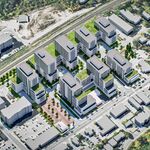mrxbombastic
Active Member
West Eglinton west (that's what I call it) has a chance to become a big deal IMO. Just as much as Sheppard (gasp!) or St Clair.
Personally St Clair is a fine street and has largely achieved its chance to become a big deal, for whatever that means. the nature of St Clair and Sheppard/Eglinton is also quite different.
Eglinton and Sheppard are going to become very different urban streets from what we might be comfortable or used to in downtown. The scale is larger. The built form is completely modern. The retail has a very different demographic to cater to. I'm completely excited to see what happens here, but I dont for a second expect it will happen overnight or be successful in its first tries. Things spring up organically as the nature of the beast changes suiting to best fill the local niche. The first run of likely corporate chains may not be the most pleasant but are the start of the future for these areas and the quality of the commercial and retail will only get better with time.




